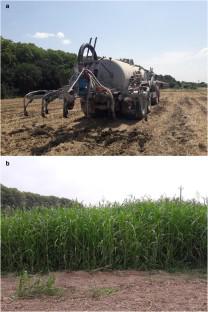Agronomy for Sustainable Development ( IF 6.4 ) Pub Date : 2022-06-21 , DOI: 10.1007/s13593-022-00790-8 Camille Launay , Sabine Houot , Sylvain Frédéric , Romain Girault , Florent Levavasseur , Sylvain Marsac , Julie Constantin

|
Some European countries are exploring the idea of replacing dedicated crops with energy cover crops for biogas production. Indeed, energy cover crops can generate consequential biomass without competing with food crops for land use. However, the potential benefits and impacts of this choice are not fully understood. Here, we review what is known about the consequences of energy cover crop usage by examining management regimes and digestate use, including impacts on the environment and cropping system performance. First, compared to cover crops, energy cover crops are intensively managed to produce more biomass (< 5 t DM/ha vs. up to 16 t DM/ha). Second, nitrogen is conserved during anaerobic digestion and is more readily available to crops in digestate than in cover crops residues. However, ammonia is lost via volatilization, which could reduce nitrogen use efficiency, depending on the storage conditions and application method. Third, 43–80% of the crops’ initial carbon is transformed into biogas. That said, levels of soil carbon storage may nonetheless resemble those obtained with cover crops left behind because carbon is stabilized during anaerobic digestion and the energy cover crops’ roots and stubble are left behind in the soil. Fourth, energy cover crops can act as multiservice cover crops, reducing nitrate leaching, improving soil microbial activity, and enhancing soil physical properties during the fallow period. Fifth, energy cover crop usage can have certain disservices, such as soil compaction, the need for additional inputs (e.g., irrigation, fertilization, pesticides), reduced groundwater recharge, and reduced following crop yield. In summary, expanding the usage of energy cover crops for biogas production does not seem to be an environmental threat. However, care must be taken to avoid the intensification of irrigation and lengthening growing periods to boost biomass, which could reduce food production.
中文翻译:

将用于沼气生产的能源覆盖作物纳入农业系统:效益和环境影响。回顾
一些欧洲国家正在探索用能源覆盖作物代替专用作物来生产沼气的想法。事实上,能源覆盖作物可以在不与粮食作物竞争土地使用的情况下产生相应的生物质。然而,这种选择的潜在好处和影响尚不完全清楚。在这里,我们通过检查管理制度和消化物的使用,包括对环境和种植系统性能的影响,回顾了对能源覆盖作物使用后果的了解。首先,与覆盖作物相比,能源覆盖作物被集中管理以产生更多的生物质(< 5 t DM/ha vs. 16 t DM/ha)。其次,氮在厌氧消化过程中是保守的,并且在消化物中的作物比在覆盖作物残留物中更容易获得。然而,氨会通过挥发而流失,这可能会降低氮的利用效率,具体取决于储存条件和应用方法。第三,43-80% 的农作物初始碳转化为沼气。尽管如此,土壤碳储存水平可能与覆盖作物留下的碳储存水平相似,因为在厌氧消化过程中碳是稳定的,而能源覆盖作物的根和残茬留在土壤中。第四,能源覆盖作物可作为多效覆盖作物,减少硝酸盐淋失,提高土壤微生物活性,增强休耕期土壤物理性质。第五,能源覆盖作物的使用可能会产生某些不利影响,例如土壤板结、需要额外投入(例如灌溉、施肥、杀虫剂)、地下水补给减少以及后续作物产量减少。总之,扩大使用能源覆盖作物生产沼气似乎不会对环境构成威胁。然而,必须注意避免加强灌溉和延长生长期以增加生物量,这可能会减少粮食产量。









































 京公网安备 11010802027423号
京公网安备 11010802027423号